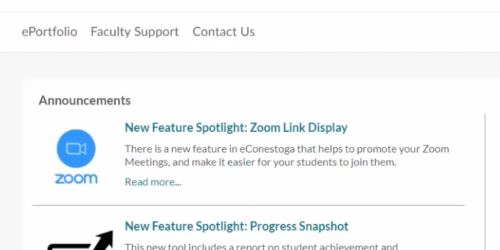Utilizing eConestoga with your In-Person and Synchronous Teaching
Explore your teaching approach and engage your students from the very beginning by unlocking the full potential of your eConestoga course shell – not just as a digital extension but as a dynamic tool that enhances your student’s learning experiences. Think about how you can leverage your course shell in class as a way to familiarize your students with the Instructional Plan, provide assistance in navigating eConestoga tools, and serve as a helpful reminder for upcoming assessments and tasks.
Course Outline
The course outline offers a comprehensive overview of the course and outlines the anticipated learning experience. How can you guide your students in understanding their course outline, a document officially approved by the college? Consider opening this document from your eConestoga course page at the beginning of the semester, preferably during the first class. Dedicate a few minutes to walking through the outline, highlighting key points. This approach underscores the importance of students taking the time to read this document and offers an opportunity for questions and clarifications on its content.
Orienting Students to the Instructional Plan
The Instructional Plan details the delivery of the course for a specific section for each semester. If you incorporate the instructional plan into your teaching approach and guide students in navigating it within your eConestoga course shell, you create an emphasis on the usefulness of this document for their academic success. As a practical strategy, consider beginning each class with the eConestoga course page opened to the Instructional Plan, providing a quick reminder to students about their position in the weekly schedule of course delivery.
For additional guidance on the Instructional Plan and how to use the Instructional Plan Builder, please refer to eConestoga Faculty Support.
Demonstrating eConestoga Tools
Throughout the semester, you might request your students to use certain eConestoga Tools, and they may require your guidance in doing so. If students have upcoming tasks to complete outside of class, consider demonstrating how to use the tool during the class session, either at the beginning or end. For instance, take a few minutes to showcase the functionality of Turnitin and guide them on interpreting the Similarity Reports. Facilitating students’ learning of the use of eConestoga tools supports their achievement of learning outcomes and fosters a positive response from students (Mohd Nasir et al., 2021).
Upcoming Assessments
A recommended approach to remind students about upcoming assessments is to access the eConestoga course page during class. Use this time to familiarize students with assessment instructions, clarify expectations for submissions or completion of evaluations, and highlight relevant due dates. This not only ensures that everyone in the class understands the assessment expectations but also offers a chance for students to ask questions for further clarification and supports student’s desire to understand assessment timelines (Kumar et al., 2020).
Consider these approaches next time you teach an in-person class with the aim of supporting students’ learning, cultivating positive student-faculty relationships, and enhancing overall student engagement (Reid, 2019). For further guidance and tips on using eConestoga, explore the Faculty Learning Hub.
References
Kumar, J. A., Bervell, B., & Osman, S. (2020). Google classroom: insights from Malaysian higher education students’ and instructors’ experiences. Education and Information Technologies, 25(5), 4175–4195.
Mohd Nasir, F. D., Hussain, M. A. M., Mohamed, H., Mohd Mokhtar, M. A., & Karim, N. A. (2021). Student Satisfaction in Using a Learning Management System (LMS) for Blended Learning Courses for Tertiary Education. Asian Journal of University Education, 17(4), 442–454.
Reid, Dr. L. (2019). Learning Management Systems: The Game Changer for Traditional Teaching and Learning at Adult and Higher Education Institutions. Global Journal of Human-Social Science, 19(July), 1–14.



